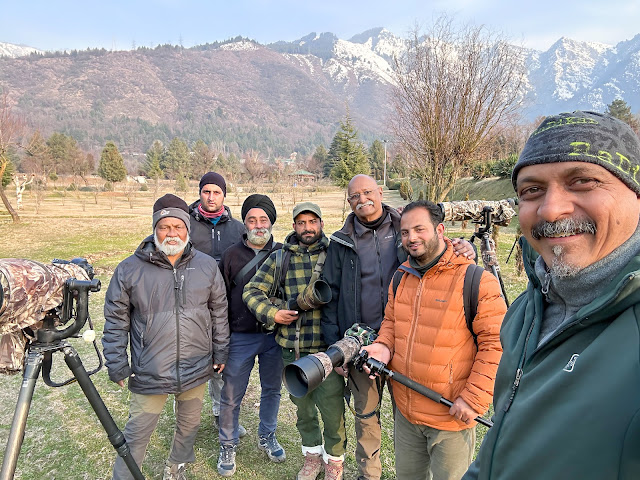Kashmir is one of the most scenic and also the most controversial tourist destinations in India. Many refer to it as the Alps of India and the Valley of Paradise!The region boasts of some exotic locations including the serene...
Kashmir is one of the most scenic and also the most controversial tourist destinations in India. Many refer to it as the Alps of India and the Valley of Paradise!
The region boasts of some exotic locations including the serene Dal Lake in Srinagar, the summer capital of the state Jammu and Kashmir. Hemmed in by the western Himalayan range and the Pir Panjal Mountains surely the region is closer to a few neighbouring countries than to some of the states in India. In the north, Gulmarg and Pahalgam are attractions for skiers and trekkers who travel in from far and wide during winters.
We had different plans as always this winter, we came in here on a direct flight to Srinagar from the city of Mumbai to see the endemic birds and the birds that fly in as winter migrants from regions as far as the Artic.
Srinagar is the city of gardens which blossom during the summer. Down and away from the Dal lakeshore are the Botanical gardens, where we came every evening to watching the birds that come and roost including a flock of Blyth's Rosefinch apart from many commoners of the region.
Being our first ever birding trip to the region, our naturalist Ansar Ahmed planned and spaced out our itinerary to ensure we covered the IBA (Important Bird Area's) during our six day long trip (9th Feb to 14th Feb 2023)
The evening of 9th Feb we did our first excursion to the Botanical Gardens, it was drizzling when we started the trek along the edge of the garden from the entrance, till we reached the core area, it had started to pour!
Yusmarg (2,396m)
The drive was under two hours by car that lead through the Charari Sharief town towards Yusmarg from Srinagar city. Just about 13-14 kms before we could reach the destination, realised the road was closed due to snowfall. We decided to trek for another 1-2 kms along the road. The habitat was amazing on one side of the road, tall pine trees and as wind blew could see the flakes fall off while on the other side were the apple trees that were dormant and had lost all its leaves and there was no activity of birds except for the large-billed crows and stray sightings of Blue-Whistling Thrushes.
 |
Blue Whistling-ThrushMyophonus caeruleus |
We heard a White-cheeked Nuthatch call from the tip of the Pine tree that is an evergreen conifer tree and seen in large numbers in the region away from the confines of the mundane, Yusmarg is a little paradise in its own right.
Low on activity we decided to trek back to the place we had left our vehicle and drive towards the town of Budgam.
The district of Budgam extends to both mountainous and plain areas of varying heights and has an average altitude 1610 m.
The majestic Kashmiri Chinar, locally called 'Bouin' is the symbol of the valley and signifies the heritage and grandeur of Kashmiri civilization.. The mighty tree is found in almost every village across Kashmir. It is said that the oldest Chinar tree in Kashmir is around 700 years old and one such tree was home to the Tawny Owl. Winter has its advantages in a way, no leaves for the bird to hide making it easy to sight. There was a very large flock of Eurasian Jackdaw's that were calling out loud a few trees away where this bird quietly kept basking in the sun and keeping a watch on onlookers like us.
 |
| Tawny OwlStrix aluco |
Enroute back to the city Ansar took us on a small hill where the Imperial Eagles were roosting, there were a couple of them, who were circling a dump yard along with Black Kites. The later can be seen in very large numbers all across the region. We did sight a few steppe eagles as well. The climb up was not too easy as it seemed, the loose mud made the boots heavy and inversely reduced the grip uphill. Suddenly the extra layered jackets seemed unnecessary due to heat generated that was after effects of the climb.
 |
| Steppe EagleAquila nipalensis |
Later part of the day was spent near a canal, where we sighted Moorhens and Grey-headed Swamphens in very large number. Occasional we could see the Common snipes that were being flushed out by the stray dogs, who were looking for a quick fresh snack. They seemed very confident and had adapted themselves to hunting in the shallow reeds. Here we did sight the Water Rail who soon disappeared and did not come out in the open.
 |
| Water RailRallus aquaticus |
Lake Wular (1,580m)
Two weeks prior to our landing, a group of five Long-tailed Duck's had arrived here and created thrill and excitement amongst many. The species could have probably migrated from either Europe or Artic region. It was recorded again after the year 1939 claimed Irfan Jeelani, who was with us today as our naturalist.
Lake Wular in the valley has an area of 189 sq kms, making it the largest freshwater lake in Asia. The drive towards the northwest of Srinagar City is very scenic. Surprisingly the birding was very low along the road to the lake. The lake and its surrounding extensive marshes have an important natural wildlife. The rivers Bohnar, Madamati and Erin from the mountain ranges and the rivers Vetasta (Jhelum) and the Ningal from the south bring hundreds of tons of silt into the lake every year.
We had to climb down a steep hill, where Shaukat (boatman) was waiting to take us around. It was cold the temperatures were below zero deg C. The wind was cutting through and the visibility was low as well. We were having mixed feelings as we learnt that only a single individual was being seen out of the five. As it was alone was moving around with a mixed flock of Common Pochard's and Eurasian Coot's and had become very shy.
 |
| Long-tailed DuckClangula hyemalis |
After moving deep into the lake, did sight the bird, but it would take flight, circle over us and settle across the other bank, that was far. In an instance, we switched off the engine and requested Shaukat to just paddle us closer. This resulted we moved into a very shallow area and got literally stuck. Though at some places the depth was not much could just get ourselves out without much trouble.
After a couple of hours we did to get to see the rarity and headed back to the shore. By now the weather had started to get clear. Here we had a local delicacy (Masala Tchot) which surely seemed like a whole meal and can be related to a bread roll stuffed with hummus and spices.
As any other day we headed back to the Botanical Garden in the city, before we head back to the Hotel and retire for the day.
Dachigam National Park (1,676m ~ 4267m)
Dachigam National Park was our destination for the day, located not far from Srinagar. Dachigam literally stands for ‘ten villages’, which could be in memory of the ten villages that were relocated in order to create the park. After taking appropriate permissions we reached the main gate it the morning. Today we were to take a battery operated vehicle into the park. On the way back we were to trek back to the main gate. The weather was even colder than the previous days. As we started to move into the park, it started to snow. Our target for the day was Orange Bullfinch, its the only time of the year when this species comes lower in altitude.
We intended to see the Orange Bullfinch that has a very limited range in northern India. It’s only in the winters that they descend to a lower altitude and can seen in areas around Srinagar, Kashmir. Though it was snowing heavily found this male to our delight along the paved path. We not only sighted the Orange Bullfinch, Black-and-yellow Grosbeak but also the Chestnut Thrush and Black-throated Thrush. Himalayan Bulbul's were seen in very large numbers (compared to other bird species) As we had sighted most the birds we could, decided to skip the trek and use the same vehicle to drop us back to the main gate. It was my shortest ever stay in any National Park.
 |
| Orange BullfinchPyrrhula aurantiaca |
 |
| Black-and-yellow GrosbeakMycerobas icterioides |
Luck was on our side so we could take time off and head towards the city and reached a nice patch of field where we got good glimpses of the Rufous-backed redstart commonly called as Eversmann's Redstart. The birds here were busy foraging and got to see a flock of Red-billed Chough. The lonely Black-throated Accentor would appear once a while and disappear into the thickets of the shrubs. Eurasian Wren, House Sparrow and Streaked Laughingthrush's were seen in good numbers here.
 |
| Black-throated AccentorPrunella atrogularis |
 |
| Rufous-backed RedstartPhoenicurus erythronotus |
Today being a Sunday, Ansar suggested and we agreed to skip the visit to the Botanical Gardens and spend the evening in the cozy room instead.
Kangan (1,810m)
We were closing closer to the end of the trip and we were yet to the sight the endemic Kashmir Nuthatch and few other migratory species. so today again it was Irfan who was to accompany us to the region where we could possibly see them.
After driving towards Sonmarg (another famous tourist destination) crossed the town of Kangan, here we decided to park off and talk a walk into a small patch of forest. The snow was knee deep in some parts and gladly had the shoes and gaiters in place that ensured the walk was easy!
After a while Irfan heard it call. It was busy foraging and hoping, twisting and moving swiftly between the branches. Here we also sighted the mixed flock of Coal Tit, Cinereous Tit.
 |
| Kashmir NuthatchSitta cashmirensis |
Later we drove back towards the town and this time we walked along some fields and along the Sindh river. The region was an excellent habitat for the buntings, who were grazing in flocks and in regular intervals were taking off to distant regions and in a while would emerge again. There were instances when we would accidentally flush them from their foraging groups, as they camouflage so well.
Along the river we sighted the Ibisbill, Little forktail. As we were returning in the evening sighted the Brambling, Pine Bunting and Yellowhammer roosting on adjoining trees. The birds that seemed difficult to approach were now roosting in front of us.
 |
| Pine BuntingEmberiza leucocephalos |
 |
| BramblingFringilla montifringilla |
 |
| YellowhammerEmberiza citrinella |
Srinagar City (1600m)
Today we spent the day just around the Botanical Garden that were situated around the base of a hill overlooking Dal Lake. From within the gardens we crossed over to tulip gardens, the well paved road made up of concrete along the side of the garden ensured we took a stress free walk. Compared to the other Mughal Garden's, this one is quiet and peaceful and it surely had more variety of birds. Ansar along with Reyan and Irfan had anticipated the sighting of the Common Chaffinch as the same were seen on the previous evening as well.
 |
| Common ChaffinchFringilla coelebs |
For a change today the weather was clear and just as evening approached sighted the bird, there were two of them, so acted like show stoppers, posing on a branch for sometime and moving on the next, in 10-15 minutes they decided to roost within the trees and we moved further to catch a glimpse of the Blyth's Rosefinch again.
 |
| Blyth's RosefinchCarpodacus grandis |
Pahalgam (2740m)
The birding trip had ended and had extended my stay to visit a few tourist location, Pahalgam was one of them. During my discussions with Ansar in Srinagar, recall he mentioning that if one tries can probably sight the Kashmir Nutcracker here. He referred me to Ishaq Lone who is an excellent naturalist for the region. After breakfast, we first went birding around the Yanner Bridge, the water levels had risen to had to cross a couple of streams by foot. The water was surely super chilled and sent cold waves across the body!
 |
| Black-crested TitPeriparus ater melanolophus |
Here we sighted the Variegated Laughingthrush in large numbers along with the streaked Laughingthrush. Later we drove into the outskirts of the Overa-Aru Wildlife Sanctuary. The place was buried in snow and managed to get to the region from where the tall pine trees were visible. Rufous-naped Tit, Cinereous Tit, White-cheeked Nuthatch and the large billed crows were seen. After trekking for more than 2 hours we had lost hope of sighting the Kashmir Nutcracker.
 |
| Rufous-naped TitPeriparus rufonuchalis |
 |
| Kashmir NutcrackerNucifraga multipunctata |
Later we trekked back and went birding along the Lidder river and sighted the Brown dipper and a pair of Ibisbill to name a few.
Sharing the detailed checklists on: https://ebird.org/india/tripreport/108711
Team:
The trip came to an end with a list of 71 birds (16 lifers) by the end of day six, Ansar Ahmed had been an excellent tour leader, who knew the locations where we could possibly find the birds we wanted to see, he also made fabulous arrangements for our lodging and boarding. The other team of co-birders Irfan Jeelani, Reyan Sofi, Ishaq Lone were very knowledgeable on the habitat and birds. Shaukat on the wheels was very entertaining and played songs that were very romantic. So we ended up calling him "Shauken Shaukat". Last but not least would like to thank my fellow birder Satish Thayapurath, Dr Ian D'souza who as always were great partners in this trip.
 |
| Satish T, Ansar Ahmed, Jagjit Singh, Reyan Sofi, Dr Ian D'souza, Irfan Jeelani and Myself (L-R) |
Route:

Happy Birding!
|
|
ANSERIFORMES: Anatidae |
|
|
|
1 |
Mallard |
Anas platyrhynchos |
|
|
2 |
Green-winged Teal |
Anas crecca |
|
|
3 |
Common Pochard |
Aythya ferina |
|
|
4 |
Long-tailed Duck |
Clangula hyemalis |
Rare/Accidental |
|
|
|
|
|
|
|
PODICIPEDIFORMES: Podicipedidae |
|
|
|
5 |
Little Grebe |
Tachybaptus ruficollis |
|
|
|
|
|
|
|
|
COLUMBIFORMES: Columbidae |
|
|
|
6 |
Rock Pigeon |
Columba livia |
|
|
|
|
|
|
|
|
GRUIFORMES: Rallidae |
|
|
|
7 |
Water Rail |
Rallus aquaticus |
|
|
8 |
Eurasian Moorhen |
Gallinula chloropus |
|
|
9 |
Eurasian Coot |
Fulica atra |
|
|
10 |
Gray-headed Swamphen |
Porphyrio poliocephalus |
|
|
|
|
|
|
|
|
CHARADRIIFORMES: Ibidorhynchidae |
|
|
|
11 |
Ibisbill |
Ibidorhyncha struthersii |
|
|
|
|
|
|
|
|
CHARADRIIFORMES: Charadriidae |
|
|
|
12 |
Red-wattled Lapwing |
Vanellus indicus |
|
|
|
|
|
|
|
|
CHARADRIIFORMES: Scolopacidae |
|
|
|
13 |
Common Snipe |
Gallinago gallinago |
|
|
14 |
Common Sandpiper |
Actitis hypoleucos |
|
|
|
|
|
|
|
|
CHARADRIIFORMES: Laridae |
|
|
|
15 |
Black-headed Gull |
Chroicocephalus ridibundus |
|
|
|
|
|
|
|
|
PELECANIFORMES: Ardeidae |
|
|
|
16 |
Gray Heron |
Ardea cinerea |
|
|
17 |
Indian Pond-Heron |
Ardeola grayii |
|
|
|
|
|
|
|
|
ACCIPITRIFORMES: Accipitridae |
|
|
|
18 |
Himalayan Griffon |
Gyps himalayensis |
|
|
19 |
Imperial Eagle |
Aquila heliaca |
|
|
20 |
Black Kite |
Milvus migrans |
|
|
|
|
|
|
|
|
STRIGIFORMES: Strigidae |
|
|
|
21 |
Tawny Owl |
Strix aluco |
|
|
|
|
|
|
|
|
CORACIIFORMES: Alcedinidae |
|
|
|
22 |
Common Kingfisher |
Alcedo atthis |
|
|
23 |
White-throated Kingfisher |
Halcyon smyrnensis |
|
|
24 |
Pied Kingfisher |
Ceryle rudis |
|
|
|
|
|
|
|
|
PICIFORMES: Picidae |
|
|
|
25 |
Brown-fronted Woodpecker |
Dendrocoptes auriceps |
|
|
26 |
Himalayan Woodpecker |
Dendrocopos himalayensis |
|
|
27 |
Scaly-bellied Woodpecker |
Picus squamatus |
|
|
|
|
|
|
|
|
PSITTACIFORMES: Psittaculidae |
|
|
|
28 |
Alexandrine Parakeet |
Psittacula eupatria |
|
|
29 |
Rose-ringed Parakeet |
Psittacula krameri |
|
|
|
|
|
|
|
|
PASSERIFORMES: Corvidae |
|
|
|
30 |
Yellow-billed Blue-Magpie |
Urocissa flavirostris |
|
|
31 |
Kashmir Nutcracker |
Nucifraga multipunctata |
|
|
32 |
Red-billed Chough |
Pyrrhocorax pyrrhocorax |
|
|
33 |
Eurasian Jackdaw |
Corvus monedula |
|
|
34 |
House Crow |
Corvus splendens |
|
|
35 |
Large-billed Crow |
Corvus macrorhynchos |
|
|
|
|
|
|
|
|
PASSERIFORMES: Paridae |
|
|
|
36 |
Coal Tit (Black-Crested) |
Periparus ater melanolophus |
|
|
37 |
Rufous-naped Tit |
Periparus rufonuchalis |
|
|
38 |
Cinereous Tit |
Parus cinereus |
|
|
|
|
|
|
|
|
PASSERIFORMES: Pycnonotidae |
|
|
|
39 |
Himalayan Bulbul |
Pycnonotus leucogenys |
|
|
40 |
Black Bulbul |
Hypsipetes leucocephalus |
|
|
|
|
|
|
|
|
PASSERIFORMES: Phylloscopidae |
|
|
|
|
|
|
|
|
41 |
Lemon-rumped Warbler |
Phylloscopus chloronotus |
|
|
|
|
|
|
|
|
PASSERIFORMES: Aegithalidae |
|
|
|
42 |
Black-throated Tit |
Aegithalos concinnus |
|
|
|
|
|
|
|
|
PASSERIFORMES: Zosteropidae |
|
|
|
43 |
Indian White-eye |
Zosterops palpebrosus |
|
|
|
|
|
|
|
|
PASSERIFORMES: Leiothrichidae |
|
|
|
44 |
Streaked Laughingthrush |
Trochalopteron lineatum |
|
|
45 |
Variegated Laughingthrush |
Trochalopteron variegatum |
|
|
|
|
|
|
|
|
PASSERIFORMES: Sittidae |
|
|
|
46 |
Kashmir Nuthatch |
Sitta cashmirensis |
|
|
47 |
White-cheeked Nuthatch |
Sitta leucopsis |
|
|
|
|
|
|
|
|
PASSERIFORMES: Certhiidae |
|
|
|
48 |
Bar-tailed Treecreeper |
Certhia himalayana |
|
|
|
|
|
|
|
|
PASSERIFORMES: Troglodytidae |
|
|
|
49 |
Eurasian Wren |
Troglodytes troglodytes |
|
|
|
|
|
|
|
|
PASSERIFORMES: Cinclidae |
|
|
|
50 |
Brown Dipper |
Cinclus pallasii |
|
|
|
|
|
|
|
|
PASSERIFORMES: Sturnidae |
|
|
|
51 |
Common Myna |
Acridotheres tristis |
|
|
|
|
|
|
|
|
PASSERIFORMES: Turdidae |
|
|
|
52 |
Chestnut Thrush |
Turdus rubrocanus |
|
|
53 |
Black-throated Thrush |
Turdus atrogularis |
|
|
|
|
|
|
|
|
PASSERIFORMES: Muscicapidae |
|
|
|
54 |
Blue Whistling-Thrush |
Myophonus caeruleus |
|
|
55 |
Little Forktail |
Enicurus scouleri |
|
|
56 |
Plumbeous Redstart |
Phoenicurus fuliginosus |
|
|
57 |
Rufous-backed Redstart |
Phoenicurus erythronotus |
|
|
58 |
White-capped Redstart |
Phoenicurus leucocephalus |
|
|
|
|
|
|
|
|
PASSERIFORMES: Prunellidae |
|
|
|
59 |
Black-throated Accentor |
Prunella atrogularis |
|
|
|
|
|
|
|
|
PASSERIFORMES: Passeridae |
|
|
|
60 |
House Sparrow |
Passer domesticus |
|
|
|
|
|
|
|
|
PASSERIFORMES: Motacillidae |
|
|
|
61 |
White Wagtail |
Motacilla alba |
|
|
|
|
|
|
|
|
PASSERIFORMES: Fringillidae |
|
|
|
62 |
Common Chaffinch |
Fringilla coelebs |
|
|
63 |
Brambling |
Fringilla montifringilla |
|
|
64 |
Black-and-yellow Grosbeak |
Mycerobas icterioides |
|
|
65 |
Blyth's Rosefinch |
Carpodacus grandis |
|
|
66 |
Orange Bullfinch |
Pyrrhula aurantiaca |
|
|
67 |
Plain Mountain Finch |
Leucosticte nemoricola |
|
|
68 |
European Goldfinch |
Carduelis carduelis |
|
|
69 |
Fire-fronted Serin |
Serinus pusillus |
|
|
|
|
|
|
|
|
PASSERIFORMES: Emberizidae |
|
|
|
70 |
Yellowhammer |
Emberiza citrinella |
|
|
71 |
Pine Bunting |
Emberiza leucocephalos |
|

















